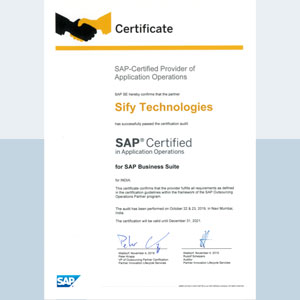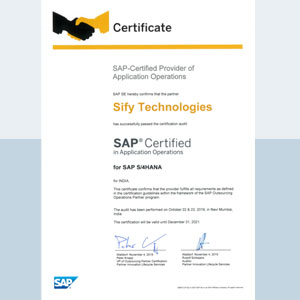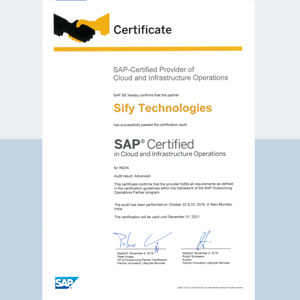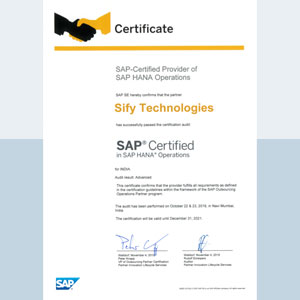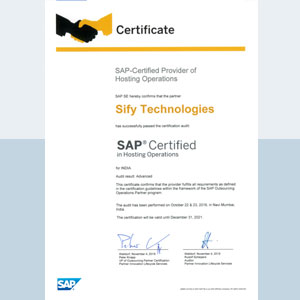The future of enterprise networking: Exploring the benefits of SD-WAN
The conversation around networking solutions has reached a critical juncture, and software-defined wide area networks (SD-WAN) have become central to this discourse. The SD-WAN market is projected to reach USD 13.7 billion by 2027, growing at a compounded rate of 31.9% annually. As enterprises demand agile, built-for-purpose, future-ready, cost-effective, and secure networking solutions, SD-WAN represents a preferable alternative to the limitations of traditional networking solutions. This article delves into the transformative business benefits of SD-WAN, its advantages over traditional WAN technologies, and why enterprises must take immediate notice.
What is SD-WAN and how has it evolved?
Consider this scenario: A retail chain with stores in multiple cities, each running different promotions, handling distinct inventory, and serving diverse customer needs. How do they ensure that all of their branches communicate efficiently with the headquarters and with each other? How do they safeguard sensitive data that is exchanged over their network?
SD-WAN emerges as a game-changing solution in these contexts. It leverages software-defined networking (SDN) to establish a more agile and responsive network ecosystem. It dynamically optimizes WAN performance, delivering an exceptional user experience.
Traditional WAN vs. SD-WAN
Traditional WAN architectures offer robust stability, compatibility with legacy systems, and regulatory compliance. Through high-quality connections like MPLS, they guarantee performance where it is critical. Being a widely adopted technology, many organizations have the in-house expertise to manage them efficiently. On the other hand, they are known for their rigidity and inefficiency, often requiring a lot of manual configurations. The lack of centralized management is also a major drawback. All of this results in higher costs, poor performance and lack of scalability.
SD-WAN revolutionizes this space by offering significant WAN optimization. SD-WAN shines in its ability to offer agile, cost-effective, and scalable networking solutions with centralized management. Leveraging software-defined networking, it optimizes traffic routes, prioritizing essential applications for enhanced performance and reliability. Additionally, built-in security features, such as end-to-end encryption, fortify the network, making it an alternative to traditional WAN technologies.
Organizations adopting SD-WAN can expect to reduce networking costs while significantly improving their bandwidth. Its fast, reliable, and secure network can handle any unprecedented surge in users. Centralized management and better visibility keep diverse locations connected efficiently.
Sify’s Managed SD-WAN: Features and benefits
Sify, a recognized niche player in the Gartner Global Managed Services Magic Quadrant, offers a cutting-edge managed SD-WAN platform, developed in collaboration with top OEMs. Sify SD-WAN helps enterprises to meet the evolving network requirements with unmatched agility, security, and scale.
- Improved performance:
Superior application steering, intelligent routing and application prioritization result in accelerated performance, reduced latency, and enhanced user experience.
- Cost savings:
SD-WAN brings down hardware costs and optimizes bandwidth and network assets utilization, helping to derive the best long-term ROI.
- Simplified management:
Centralized control, policy management and automation simplify network management, reducing manual configurations and enabling efficient scaling. Management dashboards offer granular views based on business intent.
- Enhanced security:
SD-WAN security benefits include bolstered overall network security, encrypted traffic and secure connections for remote offices.
- Application awareness:
SD-WAN excels in application-aware dynamic bandwidth allocation, particularly useful in high-demand scenarios. Pre-configured SD-WAN policies can immediately identify and prioritize latency-sensitive traffic to ensure there is no degradation in quality.
- Automatic failover:
SD-WAN’s intelligent algorithms detect congestion or failure on the primary connection, and they automatically switch traffic to a secondary connection, ensuring uninterrupted user experience.
For more insights into a best-practices-driven SD-WAN implementation, click here to learn how Sify’s SD-WAN services combine robust performance with cost-effectiveness.
Emerging trends: The future of SD-WAN
SD-WAN as-a-Service: Managed SD-WAN deployments are growing rapidly, with more enterprises choosing to outsource WAN management to specialized service providers. By 2020, this number had risen to nearly 50%, from just 8% of deployments in 2017. There has been a noticeable shift towards offering SD-WAN as-a-service, with businesses able to adopt this technology without hefty upfront investments.
SD-WAN and Secure Access Service Edge (SASE): When integrated into a SASE framework, SD-WAN benefits from an additional layer of security, which makes policy-based, secure access to network resources efficient and highly secure. For example, SD-WAN enhances secure remote access by providing encrypted pathways between remote locations and central networks. To add to this point, the focus on zero-trust security models further boosts SD-WAN’s credentials as a secure networking solution, by ensuring that all traffic is verified before access to the network is granted.
SD-WAN and Cloud: Traditional WAN architectures often struggle to efficiently route cloud-bound traffic, leading to suboptimal performance and potential security risks. SD-WAN dynamically routes traffic based on application type, quality of service requirements, and network conditions. It can identify the most efficient path to a particular cloud service and optimize the route for performance, reliability, and security. Furthermore, SD-WAN solutions often have native integrations with major cloud service providers. Such “cloud on-ramp” capabilities empower SD-WAN for rapid and secure cloud access.
SD-WAN and AI: AI-driven automation is enhancing SD-WAN by enabling smarter traffic management and improved security through anomaly detection. By integrating AI and machine learning, SD-WAN becomes capable of intelligent network optimization and predictive analytics. A unified approach (often enabled by a single management console) consolidates heterogeneous networks and traffic onto a single platform for easier management and also serves as a rich source of network and security data.
SD-WAN and the Edge: SD-WAN enables near-real-time data processing and analysis at the source, reducing latency and boosting application performance. Its dynamic traffic routing capabilities also enhance efficient data handling at distributed edge locations, allowing organizations to deliver timely insights and actions.
Conclusion: Key considerations for implementing SD-WAN
SD-WAN will play a pivotal role in the next wave of digital transformation. Organizations that are considering the switch should begin by assessing their needs and choose an SD-WAN solution or a service provider who can offer the full suite of capabilities suited to these needs.
Sify delivers a managed SD-WAN platform that enables the network agility and security needed by the modern-day enterprise. Sify’s SD-WAN platform supports customers’ network needs across a multi-service provider and multi-media environment. Learn how you can empower your network with our SD-WAN services. Learn more
Exploring India’s Potential as a Preferred Hyperscale Data Center Destination
The Indian data center market has witnessed phenomenal growth in recent years, driven by the increasing adoption of digitalization, internet penetration, e-commerce and cloud computing. Due to accelerated adoption of public cloud and data sovereignty policies, major global players are investing heavily in hyper-scale facilities, turning the nation into a hyperscale data center hub to meet the increasing demand of cloud services.
According to a report, the data center industry in India to cross 1.3 GW capacity and grow 2.4x by 2024. The hyperscale market is expected to grow 20% from 2021 to 2026, with over 300 new hyperscale sites in development globally today, that number is expected to surpass 1,000 by end of 2024.
Hyperscale Data Center Colocation Providers in India are Revolutionizing Data Center Infrastructure:
Having a data center in India has its own benefits. Several prominent data center providers have already made significant investments in data centers that offer massive colocation facilities, capable of housing high-performing servers and storage systems, providing immense computing power, storage capacity, and scalability. These data centers cater to all the needs of Public Cloud providers, global Enterprises, and OTT players, who require massive infrastructure to support their digital services and handle the exponential growth of data.
Let’s explore the reasons why India is an attractive destination for hyperscale Data Centers
- Vast market size and growing digital economy
The proliferation of data generation at edge, vast market size with favorable business environment, and India’s rapidly expanding digital economy, fuelled by the government’s Digital India initiative is making India- one of the main data centers destinations in the world. Policies aimed at data localization and data sovereignty has incentivized both domestic and international CSPs to establish hyperscale data centers in India to comply with these regulations.
- Increased adoption of cloud services in India
The increase in cloud services adoption in India reflects a broader trend of digitalization and technology-driven innovation. As organizations continue to realize the benefits of cloud computing, India is poised to play a pivotal role in the global cloud services landscape.
Cloud-born startups and automation-dependent businesses are defining the growth and scale of data center services. For instance, hybrid cloud adoption is enabling digital enterprises to leverage private infrastructure for compliance, sensitive workloads, greater control on the applications and environment, and tap into the high computing power of public clouds for bursting or scaling requirements, enabling digital innovation, and easier access to next-gen technologies like AI/ML, thus accommodating evolving business needs.
- Scalable data center campuses with growth options for up to 10 years
Scalability is one of the top challenges that hyperscalers and enterprises face as the demands on their technology systems increases. To help customers data processing seamlessly, hyperscale companies need exceptional storage, capacity, and flexibility to match their internal data processing requirements.
Hyperscale-ready data centers facilities in India are designed to become agile to cater the growing demand and meet any load they service. By setting up new availability zones set up and built-to-suit capabilities, most data center providers offer growth options for up to 10 years, enabling faster time to market in a cost-effective manner.
Sify’s data center in Rabale, Mumbai is an expandable mega data center campus designed for 10 towers, with 5 of them fully operational. The large campus has a 200 MW IT power capacity with up to 15,000+ racks. The remaining towers are in development and planning phase to favor hyperscale and retail clients’ dynamic workloads.
- Dense interconnect networks
The availability of dense interconnect networks has played a significant role in contributing to the growth of data centers in India. Hyperscale data center providers help businesses seamlessly connect to public clouds through high speed, low latency network while ensuring enhanced quality of services (QoS), secured information exchange, and guaranteed performance.
- Ample Stable power
The rapid growth of data center usage results in a growth of energy needs of the facility. Hyperscalers look for locations with access to stable and redundant power infrastructure, including multiple power grids, reliable electrical connections, and backup generators. India hosts several locations across its geographical reach that offers ample power and the capacity to scale up as hyperscalers’ operations expand. Data center providers assess the availability of power grids, transmission lines, and substations in the vicinity to attract and meet hyperscalers core requirements.
- Abundant Renewable Energy Potential
India offers substantial renewable energy potential, including solar and wind power. The country’s focus on renewable energy development aligns with the sustainability goals of hyperscale data center operators which is to make themselves carbon-neutral, making India an attractive choice for establishing environmentally friendly data centers. Most data center service providers in India are investing in green practices to meet the sustainability guidelines.
Sify data centers are green and energy-efficient data centers with 200+ MW of renewable power contracted. Additional nation-wide Green power for upcoming Data Center facilities is underway. With a reduction in carbon footprint by 28% during 2021-22, Sify ensures implementation of innovative practices to achieve low PUE (ASHRAE guidelines) and low WUE (Green Grid guidelines). It is a significant commitment to dedicated solar and wind renewable investment.
- Skilled Workforce and Technological Expertise
India has a large pool of skilled Data Center professionals with deep Subject matter expertise in electrical, mechanical and Data Center design as well as operations. India has traditionally been strong in developing IT professionals, with a strong foundation in software development, network engineering, and data management. This talent pool is critical for operating and managing hyperscale data centers. The presence of a thriving IT services industry further contributes to the availability of skilled personnel with the necessary expertise.
- Cost Advantages
India offers several cost advantages in terms of real estate, labor, and operational expenses compared to other established data center destinations. Lower land and construction costs, competitive energy prices, and ease of business driven by government support and diverse favoring policies contribute to the cost-effectiveness of establishing hyperscale data centers in India.
- Strategic Geographical Location
India’s geographic location provides a strategic advantage for international organizations seeking to expand their data center footprint. Its proximity to emerging markets in the Asia-Pacific region, the Middle East, and Africa makes India an ideal hub for serving these markets with low-latency connectivity. Hyperscale computing companies in India can act as gateways to these regions, facilitating faster data transmission and ensuring enhanced user experience.
The Mumbai subsea cable landing station serves as a key entry point for international internet traffic and facilitates high-speed connectivity to and from India. It supports global data communication and is vital for businesses and enterprises requiring robust international connectivity.
Chennai’s location along the Bay of Bengal makes it an ideal location for subsea cable landing stations. It serves as a critical gateway for international data traffic, enabling data transfer between India and other parts of the world. This connectivity is crucial for businesses, content delivery networks, and cloud service providers operating in India.
Sify data centers in Mumbai, Chennai, Noida (Delhi-NCR), Hyderabad, Kolkata, and Bangalore are strategically positioned to meet the unique needs of businesses and organizations in these expanding regions. They play a critical role in supporting government initiatives, digital transformation efforts, technological innovation, and data-driven operations.
Wrapping up!
India possesses numerous attributes that make it an attractive data center powerhouse. The country has witnessed massive infrastructure investments in the past years from International and domestic companies who recognized the potential of India as a strategic location to establish their hyperscale infrastructure. Keeping these investments and key factors in consideration, it can be assumed that in the future, the hyperscalers will invest more in India while focusing on the sustainability standards.
As India’s first commercial data center provider, Sify encompasses an extensive infrastructure with 11 DCs PAN India with 100 MW capacity. Additionally, with an aim to add 350 MW to their infrastructure by 2025, Sify will capture a large portion of the market hosting a mix of hyperscalers and retail clients.
Know more about Sify Hyperscale data centers here!!
Unlocking Growth: Scaling Repeatable IT Processes and Environments
Understanding the Need for Scalable IT Processes
- Recognising Bottlenecks
As your business grows, you may encounter bottlenecks in IT processes that hinder productivity and limit expansion. Identifying and eliminating these bottlenecks will enable smoother operations and better resource utilisation.
- Consistency and Reliability
Repeatable IT processes ensure consistent and reliable outcomes. Creating and standardising procedures improves the quality of service delivery, reduces errors, and minimises downtime.
Steps to Scale Repeatable IT Processes and Environments
- Process Documentation and Optimisation
The first step is to document existing IT processes thoroughly. Identify areas of improvement and optimise the workflows. This includes defining roles and responsibilities, setting performance metrics, and streamlining communication channels.
Related Read: Learn more about cloud optimisation and the benefits it can bring your business
- Automation and Orchestration
Leverage automation and orchestration tools to streamline repetitive tasks. Automation reduces manual errors, increases efficiency, and frees up resources to focus on more strategic initiatives.
Related Read: 6 Reasons Why Multi-Cloud Automation is Crucial for Your Business
- Scalable Infrastructure
Invest in scalable IT infrastructure that can adapt to the changing needs of your business. Embrace cloud-based solutions that allow you to upscale or downscale resources on-demand, ensuring you only pay for what you use.
- Security and Compliances
As your business expands, so does the importance of data security and compliance. Implement robust security measures and stay up-to-date with industry regulations to protect your business and gain customer trust.
- Training and Skill Development
Empower your IT team with the necessary skills and training to manage the scaled-up processes effectively. Encourage continuous learning to keep pace with the latest technological advancements.
Related Read: Discover our eLearning capabilities to support learning and development for your IT team
Benefits of Scaling Repeatable IT Processes and Environments
- Improved Efficiency and Productivity
By eliminating bottlenecks and automating repetitive tasks, your IT team can focus on more strategic projects, leading to improved overall efficiency and productivity.
- Cost Optimisation
Scalable IT processes enable you to allocate resources more effectively, reducing unnecessary expenditures. Cloud-based solutions, for instance, allow you to optimise infrastructure costs.
Related Read: How to Manage the Escalating Costs of a Cloud IT Environment
- Enhanced Customer Experience
Consistency and reliability in IT operations translate into a better customer experience. Customers appreciate seamless service delivery and prompt issue resolution.
- Agility and Innovation
A well-organised and scalable IT environment provides the agility needed to adapt to market changes and seize new opportunities. It empowers your business to stay ahead of the competition.
- Business Growth
As your IT processes become more efficient and adaptable, your business can handle increased workloads and expand its offerings, fostering sustainable growth.
Conclusion
Scaling repeatable IT processes and environments is a strategic move that every IT leader in the UK should consider. It empowers your business to handle growth efficiently while optimising costs and providing a superior customer experience. Embrace automation, invest in scalable infrastructure, and prioritise security and compliance to unlock the full potential of your IT operations. By doing so, your business will be well-positioned to thrive in the digital landscape and pave the way for future success.How a Partner Can Help
The discovery phase of exploring and documenting repeatable IT processes and environments can be a slow and difficult task if you are relying on in-house resources alone. An IT partner can add value by bringing their experience and specialist knowledge to support the process and achieve outcomes faster and more accurately. Sify specialises in delivering flexible IT expertise to maximise efficiency, productivity, and affordability. We are ideally placed to help you build a sustainable, fully optimised cloud infrastructure that meets your long-term business needs. Sify offers deep expertise in all areas of cloud and IT infrastructure, combined with proven methodologies and frameworks to help analyse, design and optimise cloud environments. Our proven experience and expertise have delivered for organisations seeking to optimise their cloud infrastructures, including reducing costs and ensuring resources are right sized, accelerating deployment time for new applications, improving alignment between business functions and helping firms integrate new cloud-based technologies such as AI or analytics.Related Read: 5 Benefits of Using an IT Partner to Support Cloud Optimisation
The Key Challenges We Solve
With a heritage in IT Infrastructure, Sify has grown over two decades to provide a one-stop engagement across networks, data centre, cloud, digital and IT services. Sify enables you to build an IT infrastructure that underpins business profitability, by delivering flexible expertise to fill IT skills gaps, and by deploying, managing and optimising complex hybrid environments to deliver the right combination of flexibility, security and affordability. Here are the key challenges our Managed Services can help your organisation solve:
Optimisation Future-proof your business by optimising your use of cloud technology

Resources Increase responsiveness with access to the right scale and calibre of specialist IT skills as and when you need them
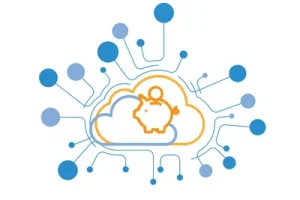
Cost Savings Make your IT budget go further by lowering your costs and becoming more efficient

Reduce Risk Control your risks by ensuring the security and resilience of your IT infrastructure
A Guide to Leveraging Professional Services for Cloud IT Skills
Understand the Challenge of Cloud Technology Talent Acquisition
Cloud technologies are continuously evolving, introducing new tools, platforms, and frameworks. It is challenging for any business to attract and retain skilled IT professionals who are well-versed in the latest cloud trends and continue to be over time. Often, limited budgets and resources can restrict investment in extensive training programs for existing team members.Benefits of Partnering with a Professional Services Company
- Access to Specialised Talent
A professional services company specialising in cloud technologies can provide access to a large pool of highly skilled and experienced professionals across different platforms. These experts stay up-to-date with the latest developments and can quickly adapt to emerging trends.
- Cost-Effective Solution
Hiring full-time employees with specific cloud expertise can be costly. On the other hand, engaging a professional services company allows you to tap into the skills you need on a project-by-project basis, saving you time and resources.
- Focus on Core Competencies
By outsourcing cloud technology needs to a professional services company, your in-house IT team can concentrate on strategic initiatives and core business activities, increasing overall productivity.
- Scalability and Flexibility
Professional services companies can scale their resources according to your project requirements, providing the flexibility to adapt to changing IT demands without the need for long-term commitments.
Key Considerations for Choosing a Professional Services Company
- Specialist Expertise
Look for a professional services company with a proven track record of successful cloud technology projects. Check their expertise in the specific cloud platforms and technologies that align with your business needs. Look for partners with a large pool of talent they can call upon when needed across the major platforms and technologies.
- Cultural Fit
Ensure that the company’s values and work culture align with your organisation’s culture. The best partners are easily reachable and responsive, agile and flexible to work with and have a can-do mindset to get things done. A strong cultural fit fosters effective collaboration and communication between teams.
- Security and Compliance
Ensure the company has a robust security and compliance framework in place to protect your data and sensitive information.
Navigate the Process of Partnering with a Professional Services Company
- Define Your Objectives
Clearly outline your cloud technology goals and requirements. This will help the professional services company understand your needs and propose the right solutions.
- Collaborative Planning
Work closely with the company to develop a well-defined project plan, including timelines, deliverables, and milestones. Effective communication is crucial for successful collaboration.
- Skill Augmentation and Training
Consider how the professional services company can augment your existing IT team and transfer knowledge to your employees. This knowledge transfer ensures your team can manage certain tasks independently in the future.
- Evaluate and Adjust
Regularly assess the progress and outcomes of the partnership. Seek feedback from your team and the professional services company to make necessary adjustments and improvements.
- Embrace Continuous Learning
Cloud technologies will continue to evolve, and it is essential to stay updated on the latest trends and best practices. Encourage your in-house IT team to participate in relevant training programs and certifications to complement the expertise provided by the professional services company.
Conclusion
In the rapidly changing landscape of cloud technologies, staying competitive requires constant innovation and access to the right IT skills. Partnering with a professional services company offers a strategic advantage, providing access to specialised talent, cost-effective solutions, and scalability. By carefully selecting the right company, defining clear objectives, and fostering effective collaboration, you can leverage their expertise to drive your business forward, adapt to emerging cloud technologies, and embrace growth opportunities in the dynamic UK market. Remember, continuous learning and knowledge transfer are key to sustaining your company’s success in the ever-evolving cloud ecosystem.How Sify Can Help
Sify is ideally placed to help businesses build a sustainable, fully optimised cloud infrastructure that meets long-term business needs. Sify offers deep expertise in all areas of cloud and IT infrastructure, combined with proven methodologies and frameworks to help analyse, design and optimise cloud environments. Our proven experience and expertise have delivered for organisations seeking to optimise their cloud infrastructures, including reducing costs and ensuring resources are right sized, accelerating deployment time for new applications, improving alignment between business functions and helping firms integrate new cloud-based technologies such as AI or analytics.The Key Challenges We Solve
With a heritage in IT Infrastructure, Sify has grown over two decades to provide a one-stop engagement across networks, data centre, cloud, digital and IT services. Sify enables you to build an IT infrastructure that underpins business profitability, by delivering flexible expertise to fill IT skills gaps, and by deploying, managing and optimising complex hybrid environments to deliver the right combination of flexibility, security and affordability. Here are the key challenges our Managed Services can help your organisation solve:
Optimisation
Future-proof your business by optimising your use of cloud technology

Resources
Increase responsiveness with access to the right scale and calibre of specialist IT skills as and when you need them

Cost Savings
Make your IT budget go further by lowering your costs and becoming more efficient

Reduce Risk
Control your risks by ensuring the security and resilience of your IT infrastructure
Maximising Productivity: Doing More with Less
Streamline Workflows and Processes
A key aspect of increasing productivity is streamlining workflows and processes. Conduct a thorough review of your IT operations and identify inefficiencies or bottlenecks. Implementing agile and lean principles and process optimisation can help your team work smarter and more efficiently, reducing time wastage and improving overall productivity.- Faster project completion times
- Reduced error rates
- Improved collaboration among teams
- Enhanced resource allocation
Embrace Automation and AI
Automation and Artificial Intelligence (AI) technologies have the potential to revolutionise your business operations. Identify repetitive and rule-based tasks that can be automated, allowing your employees to focus on more creative and strategic endeavours.- Increased speed and accuracy of tasks
- Consistent performance across processes
- Lower operational costs
- Data-driven insights for better decision-making
Invest in Employee Learning and Development
Your workforce is your most valuable asset. Invest in employee training and skill development to equip them with the knowledge and expertise needed to handle complex tasks efficiently. Everyone learns differently, so invest time in understanding your learners and build bespoke learning programs to maximise the chances of a successful program.- Improved employee morale and job satisfaction
- Enhanced problem-solving abilities
- Reduced dependency on external resources
- Increased adaptability to technological advancements
Adopt Remote Work and Flexible Policies
The COVID-19 pandemic forced many businesses to embrace remote work, and it has proven to be an effective way to increase productivity. Consider adopting flexible work policies that allow your employees to work from home or choose their working hours, as this can lead to a significant boost in their productivity and overall job satisfaction.- Greater work-life balance for employees
- Increased employee retention
- Access to a broader talent pool
- Reduced overhead costs for office space and utilities
Leverage the Cloud
Migrating all or part of your IT infrastructure and applications to the cloud can offer a myriad of productivity benefits. Cloud technology provides scalability, accessibility, and collaboration opportunities that can transform the way your business operates.- Reduced IT maintenance and hardware costs
- Seamless data sharing and collaboration
- Enhanced data security and disaster recovery capabilities
- Real-time access to applications and data from anywhere
Implement Project Management Tools
Effective project management is vital for optimising productivity within your organisation. Implement project management tools that facilitate better communication, task tracking, and progress monitoring. Such tools enable you to manage projects efficiently and ensure that deadlines are met.- Improved project planning and execution
- Enhanced team collaboration and coordination
- Clear visibility into project progress and resource allocation
- Minimise project delays and budget overruns
Encourage a Culture of Innovation
Foster a culture of innovation and continuous improvement within your organisation by acting as a thought leader for your team and business. Encourage your team to come up with new ideas and initiatives that can drive productivity and efficiency.- Increased employee engagement and creativity
- Early adoption of technological advancements
- Solutions to previously unresolved challenges
- Enhanced competitiveness and adaptability in the market
Conclusion
Managing complexity in cloud computing is vital for organisations seeking to leverage the full potential of the cloud. By adopting strategies such as designing for scalability, automation, comprehensive monitoring, embracing DevOps practices, and implementing robust security measures, businesses can effectively mitigate complexity-related challenges. Leveraging managed services, emphasising documentation and knowledge sharing, and continuous optimisation and cost management further contribute to a seamless cloud experience. With these strategies in place, organisations can harness the power of the cloud to drive innovation, enhance productivity, and achieve their business goals.How Sify Can Help
Sify is ideally placed to help businesses build a sustainable, fully optimised cloud infrastructure that meets long-term business needs. Sify offers deep expertise in all areas of cloud and IT infrastructure, combined with proven methodologies and frameworks to help analyse, design and optimise cloud environments. Our proven experience and expertise have delivered for organisations seeking to optimise their cloud infrastructures, including reducing costs and ensuring resources are right sized, accelerating deployment time for new applications, improving alignment between business functions and helping firms integrate new cloud-based technologies such as AI or analytics. Related Read: 5 Benefits of Using an IT Partner to Support Cloud OptimisationThe Key Challenges We Solve
With a heritage in IT Infrastructure, Sify has grown over two decades to provide a one-stop engagement across networks, data centre, cloud, digital and IT services. Sify enables you to build an IT infrastructure that underpins business profitability, by delivering flexible expertise to fill IT skills gaps, and by deploying, managing and optimising complex hybrid environments to deliver the right combination of flexibility, security and affordability. Here are the key challenges our Managed Services can help your organisation solve:
Optimisation
Future-proof your business by optimising your use of cloud technology

Resources
Increase responsiveness with access to the right scale and calibre of specialist IT skills as and when you need them

Cost Savings
Make your IT budget go further by lowering your costs and becoming more efficient

Reduce Risk
Control your risks by ensuring the security and resilience of your IT infrastructure
Managing Complexity in Cloud Computing: Strategies for a Seamless Experience
Designing for Scalability
To effectively manage complexity, it is essential to design cloud architectures with scalability in mind. This involves implementing elastic scaling mechanisms that allow resources to automatically adjust based on demand. By designing for scalability, organisations can dynamically allocate resources, optimise performance, and ensure a seamless experience for users.Automating Deployment and Management
Automation plays a pivotal role in managing complexity in the cloud. Leveraging infrastructure-as-code (IaC) and configuration management tools, organisations can automate the deployment, configuration, and management of cloud resources. This minimises manual errors, reduces operational overheads, and enables rapid provisioning, scaling, and recovery. Related Read: 6 Reasons Why Multi-Cloud Automation is Crucial for Your BusinessImplementing Comprehensive Monitoring
Effective monitoring is indispensable for managing complexity in the cloud. By implementing robust monitoring solutions, organisations can gain real-time visibility into their cloud infrastructure, applications, and performance metrics. This empowers them to detect and troubleshoot issues promptly, optimise resource utilisation, and ensure high availability and performance.Embracing DevOps Practices
Adopting DevOps practices promotes collaboration, transparency, and agility in cloud environments. By integrating development and operations teams, organisations can automate processes, foster continuous integration and deployment, and implement feedback loops. This streamlines workflows, accelerates innovation, and mitigates complexity-related challenges.Implementing Security Best Practices
Cloud complexity brings along security risks that must be effectively managed. Organisations should adopt a multi-layered security approach, leveraging tools like encryption, access controls, and intrusion detection systems. Regular security audits, patch management, and employee training ensure a robust security posture in the cloud, protecting against potential threats and data breaches.Utilising Managed Services
Managed services provided by cloud service providers (CSPs) offer a viable solution to reduce complexity. By outsourcing certain operational aspects to CSPs, organisations can leverage their expertise, gain access to advanced tools, and offload routine tasks. This enables businesses to focus on core competencies while relying on specialised support to manage complex cloud infrastructure. Related Read: 5 Benefits of Using an IT Partner to Support Cloud OptimisationEmphasising Documentation and Knowledge Sharing
Documentation and knowledge sharing are crucial for managing complexity, especially in large-scale cloud environments. Creating comprehensive documentation, architectural diagrams, and runbooks allows teams to understand and manage the system effectively. Establishing knowledge-sharing practices, such as internal wikis or regular training sessions, ensures that teams stay updated and can resolve issues efficiently.Continuous Optimisation and Cost Management
Cloud environments can quickly become complex and expensive if not carefully optimised and managed. Regular performance analysis, resource right-sizing, and cost optimisation exercises are essential to control complexity and keep cloud costs in check. By continuously monitoring and fine-tuning the cloud infrastructure, organisations can maximise efficiency, identify waste, and make informed decisions to optimise their cloud expenditure. Related Read: How to Manage the Escalating Costs of a Cloud IT EnvironmentConclusion
Managing complexity in cloud computing is vital for organisations seeking to leverage the full potential of the cloud. By adopting strategies such as designing for scalability, automation, comprehensive monitoring, embracing DevOps practices, and implementing robust security measures, businesses can effectively mitigate complexity-related challenges. Leveraging managed services, emphasising documentation and knowledge sharing, and continuous optimisation and cost management further contribute to a seamless cloud experience. With these strategies in place, organisations can harness the power of the cloud to drive innovation, enhance productivity, and achieve their business goals.How Sify Can Help
Sify is ideally placed to help businesses build a sustainable, fully optimised cloud infrastructure that meets long-term business needs. Sify offers deep expertise in all areas of cloud and IT infrastructure, combined with proven methodologies and frameworks to help analyse, design and optimise cloud environments. Our proven experience and expertise have delivered for organisations seeking to optimise their cloud infrastructures, including reducing costs and ensuring resources are right sized, accelerating deployment time for new applications, improving alignment between business functions and helping firms integrate new cloud-based technologies such as AI or analytics.The Key Challenges We Solve
With a heritage in IT Infrastructure, Sify has grown over two decades to provide a one-stop engagement across networks, data centre, cloud, digital and IT services. Sify enables you to build an IT infrastructure that underpins business profitability, by delivering flexible expertise to fill IT skills gaps, and by deploying, managing and optimising complex hybrid environments to deliver the right combination of flexibility, security and affordability. Here are the key challenges our Managed Services can help your organisation solve:
Optimisation
Future-proof your business by optimising your use of cloud technology

Resources
Increase responsiveness with access to the right scale and calibre of specialist IT skills as and when you need them

Cost Savings
Make your IT budget go further by lowering your costs and becoming more efficient

Reduce Risk
Control your risks by ensuring the security and resilience of your IT infrastructure
How to Boost Employee Productivity Through Digital Learning
Promoting Self-Directed Learning
Digital learning empowers employees to take charge of their professional growth. By offering a range of learning content such as courses, webinars, and tutorials on a digital platform, you can encourage staff to pursue learning opportunities that align with their interests and career goals. This self-directed approach allows employees to learn at their own pace and delve deeper into areas of interest, resulting in increased engagement and motivation. As employees become more skilled and knowledgeable, their productivity naturally improves, leading to better overall performance.Flexibility and Accessibility
Traditional learning methods often require employees to attend workshops or classes at specific times and locations, which can be disruptive to their work schedules. Digital learning eliminates these barriers by providing flexible access to educational resources anytime, anywhere. Employees can engage in learning activities during downtime, whether it’s during their commute, lunch breaks, or after work hours. This accessibility ensures that learning becomes a seamless part of their routine, maximising their productivity by utilising the time that would otherwise go unused.Microlearning for Bite-Sized Knowledge
The beauty of digital learning lies in its ability to deliver information in bite-sized, digestible chunks. Microlearning refers to short, focused learning modules that address specific topics or skills. By breaking down complex concepts into smaller, easily consumable pieces, employees can absorb information more effectively. Related Read: The Benefits of Bite-Sized Learning and How To Build It Microlearning encourages continuous learning throughout the workday, allowing employees to quickly acquire new skills and knowledge without feeling overwhelmed. This approach ensures that learning becomes a seamless part of their workflow, enhancing productivity without causing significant disruptions.Gamification and Engagement
Incorporating gamification elements into digital learning platforms can significantly boost employee engagement and motivation. Gamified learning experiences, such as quizzes, challenges, and leaderboards, tap into the natural human inclination for competition and achievement. Related Read: 6 Killer Examples of Gamification in Digital Learning By turning learning into a fun and interactive experience, employees are more likely to be fully engaged, leading to increased knowledge retention and productivity. Gamification can also encourage a sense of camaraderie and healthy competition among colleagues, further fuelling motivation and collaboration within the organisation.Personalised Learning Paths
Every employee has unique skills, interests, and areas for improvement. Digital learning platforms offer the ability to personalise learning paths based on individual needs and goals. By utilising assessments or surveys, you can identify knowledge gaps and recommend targeted learning resources to fill them. This tailored approach ensures that employees receive the most relevant and impactful training, accelerating their development and ultimately improving their productivity. When employees feel that their professional growth is valued and supported, they are more likely to excel in their roles.Continuous Learning Culture
Digital learning enables the cultivation of a continuous learning culture within organisations. By fostering an environment that promotes ongoing learning and professional development, you can nurture a workforce that is adaptive and agile. When employees understand that learning is a lifelong journey, they are more inclined to seek out new knowledge and skills to stay ahead in their fields. This proactive mindset leads to higher productivity, as employees are constantly evolving and applying newfound knowledge to their roles, driving innovation and efficiency within the organisation.Conclusion
Digital learning has the potential to revolutionise the way you approach employee development and productivity. By harnessing the power of self-directed learning, flexibility, microlearning, gamification, personalisation, and continuous learning culture, you can empower your employees to reach their full potential. Investing in digital learning not only enhances employee skills and knowledge but also promotes a motivated and engaged workforce that contributes to the long-term success of your organisation. Embrace the digital learning revolution and unlock the limitless potential of your employees.How Sify Can Help
Sify provides specialist digital learning services that offer the complete learning solution you need to attract, nurture and retain the best business talent. We understand a successful learning program is an evolving journey because you are dealing with a constantly changing audience. That is why we work in partnership with you to design, implement and optimise your learning program. Sify helps organisations succeed with their learning goals of boosting employee productivity, reducing staff turnover and improving company culture.Our Digital Learning Services
Custom
We work with you to understand the unique goals of your learning and development program. From here, our learning experts will design and implement custom learning content to meet your goals.
Off the Shelf
Extensive learning content covering thousands of courses, videos and eBooks on topics like Leadership, Management, Personal Development, Technology & Developer and Compliance.
Localisation
Our localisation and translation services will transform your content into assets that will feel natural and local for the end-users as if they have been specifically made for them.
6 Advantages of Working With a Specialist Digital Learning Partner
Access to Expertise and Experience
Specialist digital learning partners bring a wealth of expertise and experience to the table. They possess a deep understanding of instructional design principles, learning technologies, and learning methodologies. By partnering with them, businesses gain access to a team of professionals who specialise in creating engaging and effective learning experiences. These experts have a finger on the pulse of the latest trends and innovations in the field, ensuring that the learning program stays relevant and impactful.Accelerated Time to Market
Developing a comprehensive digital learning program in-house can be a time-consuming process, requiring substantial investments in research, design, content creation, and technology implementation. By partnering with a specialist digital learning provider, businesses can significantly reduce the time to market for their learning initiatives. These partners have existing frameworks, templates, and proven processes in place, allowing for faster program development and deployment. This accelerated timeline enables businesses to quickly meet their training needs and adapt to rapidly changing business requirements. Related Read: Custom Learning Content to Maximise Learner EffectivenessCost-Effectiveness and Resource Optimisation
Building an in-house digital learning team requires significant investments in hiring and training instructional designers, content creators, learning technologists, and other specialists. It also involves ongoing expenses related to infrastructure, learning management systems (LMS), and software licenses. Partnering with a specialist digital learning provider can be a cost-effective solution. Businesses can leverage the provider’s existing resources, infrastructure, and technology, saving on upfront and ongoing costs. This allows you to optimise your budget and allocate resources to other strategic initiatives. Related Read: How to Measure Return on Investment from a Learning ProgramCutting-Edge Technologies and Innovation
Digital learning partners are at the forefront of leveraging cutting-edge technologies and innovation in the learning and development space. They stay up to date on emerging trends such as augmented reality (AR), virtual reality (VR), gamification, and blended learning.Scalability and Flexibility
As your business grows or adapts to changing training needs, scalability and flexibility become critical considerations. A specialist digital learning partner offers the ability to scale resources and adapt to evolving requirements quickly. They can handle increased training volumes, expanding workforce sizes, or the need to incorporate new content areas seamlessly. This scalability ensures that the learning program can keep pace with your organisation’s growth and evolving learning needs without compromising quality or causing disruptions.Continuous Support and Maintenance
Digital learning partners provide ongoing support and maintenance for your learning program. They address technical issues, troubleshoot problems, and ensure smooth program operation. Additionally, they keep the learning content up-to-date, aligned with industry standards, and compliant with regulatory requirements. This ongoing support and maintenance alleviate the burden on internal teams, allowing them to focus on strategic initiatives while relying on the expertise of the partner to ensure a seamless learning experience.Conclusion
Partnering with a specialist digital learning provider brings numerous advantages to businesses seeking to optimise their learning initiatives. By accessing expertise, accelerating time to market, optimising costs, embracing innovative technologies, facilitating scalability, and benefiting from continuous support, businesses can create powerful learning experiences that enhance employee performance, drive organisational growth, and promote a culture of continuous learning.How Sify Can Help
Sify provides specialist digital learning services that offer the complete learning solution you need to attract, nurture and retain the best business talent. We understand a successful learning program is an evolving journey because you are dealing with a constantly changing audience. That is why we work in partnership with you to design, implement and optimise your learning program. Sify helps organisations succeed with their learning goals of boosting employee productivity, reducing staff turnover and improving company culture.Our Digital Learning Services
Custom
We work with you to understand the unique goals of your learning and development program. From here, our learning experts will design and implement custom learning content to meet your goals.
Off the Shelf
Extensive learning content covering thousands of courses, videos and eBooks on topics like Leadership, Management, Personal Development, Technology & Developer and Compliance.
Localisation
Our localisation and translation services will transform your content into assets that will feel natural and local for the end-users as if they have been specifically made for them.
8 Steps to Building a Successful Digital Learning Program
1. Define Clear Objectives and Learning Outcomes
The first step in building a successful digital learning program is to define clear objectives and learning outcomes. Consider the specific needs and goals of your organisation and its employees. Are you looking to enhance specific job-related skills, further leadership development, or promote cross-functional knowledge? By clarifying the desired outcomes, you can work backwards to tailor the program’s content, structure, and assessment methods accordingly.2. Conduct a Training Needs Assessment
Before launching a digital learning program, conduct a thorough training needs assessment to identify knowledge gaps and areas for improvement. This can be done through surveys, interviews, or performance evaluations. Gather feedback from employees, managers, and stakeholders to gain a comprehensive understanding of the skills and competencies that need to be addressed. This assessment will inform the selection of learning resources and topics to be included in the program.3. Choose the Right Learning Platform
Selecting the right digital learning platform is crucial for the success of your program. Look for a platform that offers a user-friendly interface, mobile accessibility, and a range of features such as interactive content, progress tracking, and certification options. Consider whether you need a pre-built learning management system (LMS) or if a customisable solution is more suitable for your organisation’s unique requirements. Evaluate potential platforms based on their scalability, security, and compatibility with your existing systems.4. Curate Engaging and Relevant Content
Engaging and relevant content is at the heart of a successful digital learning program. Here you have two options. One is custom learning content, which is bespoke, original content such as blending learning, virtual reality, augmented reality and gamification. Related Read: Using Virtual Reality for Unconscious Bias Training Case Study The second is off-the-shelf learning content, which offers pre-curated assets on a variety of subjects such as professional development, leadership, management, technology & development and compliance. You can also use a combination of both learning content types to suit your needs. My advice is to leverage a mix of formats, such as videos, interactive modules, quizzes, and case studies, to cater to diverse learning styles. Ensure that the content is kept up-to-date, aligned with industry trends, and easily digestible. Regularly update and refresh the content to keep learners engaged and motivated.5. In-house Resources vs a Digital Learning Partner
Ultimately, the decision to build and maintain a digital learning program in-house or with a partner depends on your resources, expertise, specific needs, and strategic priorities. With both options, developing and maintaining a learning program requires significant investments in terms of time, expertise, technology, and dedicated staff. Also, scaling a program to accommodate a growing workforce or expanding training needs should be a consideration. Two key advantages of a specialist digital learning partner are usually their experience and scale. They give you access to their expertise, experience, and best practices in designing and delivering effective digital learning programs. Secondly, partners can often scale resources and adapt to changing training needs quickly, making it easier to accommodate a growing workforce or evolving business requirements. Related Read: How to Measure Return on Investment from a Learning Program6. Drive Interactive and Collaborative Learning Experiences
Promote interactive and collaborative learning experiences within your digital program. Incorporate discussion forums, chat functionalities, and social learning features to encourage knowledge sharing and peer-to-peer engagement. Facilitate virtual discussions, group projects, and online communities to foster a sense of connection and collaboration among learners. Encourage learners to provide feedback, ask questions, and share their experiences to create a dynamic and supportive learning environment.7. Implement Continuous Assessment and Feedback Mechanisms
Continuous assessment and feedback mechanisms are vital for measuring the effectiveness of your digital learning program. Incorporate formative assessments throughout the program to evaluate learners’ progress and understanding. Use quizzes, simulations, and practical exercises to reinforce learning outcomes. Collect feedback from learners to identify areas of improvement and make necessary adjustments to the program. Regularly analyse data and metrics to measure the program’s impact on employee performance and overall organisational success.8. Encourage Continuous Learning and Development
A successful digital learning program should not end with completion certificates. Encourage a culture of continuous learning and development within your organisation. Provide opportunities for further skill-building, advanced certifications, and access to additional resources. Promote the integration of learning into employees’ daily workflow and encourage them to set personal learning goals aligned with their career aspirations. Recognise and reward employees who actively engage in continuous learning, creating a culture that values professional growth. Related Read: The Key Benefits of Digital Learning within a Learning ProgramConclusion
Building a successful digital learning program requires thoughtful planning, strategic execution, and a commitment to continuous improvement. By following the steps, we have outlined in this article, it is a great starting point for you to create a powerful learning ecosystem that empowers employees and drives organisational success. Embrace the digital learning revolution and unlock the potential for growth and development within your workforce.How Sify Can Help
Sify provides specialist digital learning services that offer the complete learning solution you need to attract, nurture and retain the best business talent. We understand a successful learning program is an evolving journey because you are dealing with a constantly changing audience. That is why we work in partnership with you to design, implement and optimise your learning program. Sify helps organisations succeed with their learning goals of boosting employee productivity, reducing staff turnover and improving company culture.Our Digital Learning Services
Custom
We work with you to understand the unique goals of your learning and development program. From here, our learning experts will design and implement custom learning content to meet your goals.
Off the Shelf
Extensive learning content covering thousands of courses, videos and eBooks on topics like Leadership, Management, Personal Development, Technology & Developer and Compliance.
Localisation
Our localisation and translation services will transform your content into assets that will feel natural and local for the end-users as if they have been specifically made for them.
Role of Enterprise Managed Wi-Fi in the Era of IoT and Smart Devices
In the rapidly evolving landscape of the Internet of Things (IoT) and smart devices, reliable and efficient connectivity is paramount. Managed Wi-Fi services play a crucial role in enabling seamless communication and data exchange between IoT devices. The explosion of mobility & BYOD, enterprise virtualized applications moving to the cloud, increased use of multimedia-rich applications within the enterprise, and infrastructure modernization are a few of the core business drivers for increased adoption of enterprise managed Wi-Fi services.
With unprecedented advancements in IoT, data modeling, and AI/ML, there is a consistently growing focus on edge computing and its benefits. Enterprises are accelerating efforts to move to the cloud for on-demand computing, capacity, scale, better reach, scalability, and higher availability. Additionally, the managed Wifi services eliminate the traditional Wi-Fi challenges like lack of uniform access policy, no visibility into the wireless network, inadequate protection against wireless threats, complex or tedious onboarding process, and lack of visibility on user groups.
According to Marketsandmarkets, the global edge computing market size as per revenue surpassed $44.7 billion in 2022 and can rise to $101.3 billion by 2027 at a CAGR of 17.8% for the forecasted period (2022-2027).
This blog explores the significance of Enterprise Managed Wi-Fi services in supporting the proliferation of IoT and smart devices, the challenges they address, and the benefits they bring to businesses and consumers.
- Connectivity and device management
Managed Wi-Fi services offer a fully managed, secure wireless platform integrating Information Technology (IT), Operation Technology (OT), and people. It provides a robust infrastructure for connecting and managing a multitude of IoT devices. It offers a cloud-based centralized management platform with control and monitoring capabilities enabling enterprises to configure and manage their IoT devices efficiently. From provisioning and onboarding to security protocols and firmware updates, these services streamline the device lifecycle, reducing operational complexities and enhancing overall device management. - Security and data protection
Managed Wi-Fi services enable a security posture which is crucial in the IoT landscape. The managed Wi-Fi services offer robust security features to protect IoT devices and the data they generate. By processing sensitive data locally or within a private network using network segmentation, edge devices can minimize data exposure to potential cyber threats as they’re isolated from other network resources. Managed Wi-Fi services also enable regular security updates and patches to address emerging threats, enhancing the overall security posture of IoT deployments. - Bandwidth management
With the growing adoption of connected devices, scalability becomes a critical factor as transmitting a large amount of data to the cloud for processing can strain network bandwidth and incur significant costs. Enterprise Managed Wi-Fi services are designed to handle large-scale deployments enabling enterprises to seamlessly scale their IoT networks. Enterprises can prioritize critical applications and optimize network resources using advanced bandwidth management techniques to ensure IoT devices receive the optimal bandwidth for their operations, preventing congestion, maintaining smooth communication between devices, and more efficient network utilization. - Reliability and performance
IoT applications and Smart devices often require real-time data exchange and low-latency connectivity. Managed Wi-Fi ensures high reliability and performance for IoT devices by optimizing network configurations and minimizing interference. They employ techniques like load balancing, channel selection, and Quality of Service (QoS) prioritization to maintain a stable and responsive Wi-Fi network. Edge computing reduces the latency required for sending data to a remote cloud server for processing. By processing data at the edge of the network, closer to the devices generating the data, response times can be significantly reduced. It is important for applications that require real-time or near-real-time processing, such as industrial automation and remote monitoring. - Analytics and insights
Enterprise Managed Wi-Fi enables real-time analytics into network performance and device behavior, giving enterprises decision-making capabilities at the network edge. They collect and analyze data on network traffic, device connectivity, and usage patterns, offering actionable intelligence to optimize network resources and improve overall IoT operations. These insights can help identify potential bottlenecks, optimize device placement, and enhance user experiences. Additionally, analytics-driven predictive maintenance can proactively detect and address anomalies, reducing downtime and increasing the lifespan of IoT devices. - Scalability and cost-efficiency
Edge computing allows for distributed computing resources, enabling scalability and cost-efficiency. Instead of relying solely on centralized cloud infrastructure, edge devices can share the computational load and distribute the processing tasks. It can result in reduced network congestion, lower costs associated with cloud resources, and improved scalability to accommodate the increasing number of IoT devices and data volumes.
Wrapping up!
With the growing digital landscape and IoT integration across enterprises, the need to deliver secure, seamless customer and employee experiences become a top priority. Enterprise Managed Wi-Fi services provide a reliable and secure connectivity infrastructure to deliver seamless device management, ensure scalability, optimize network resources, quick & accurate decision making, enhanced production planning, logistics, complete mobility for your workforce, and lower IT support costs.
As the IoT landscape continues to expand, Managed Wi-Fi services will remain crucial in delivering seamless and efficient connectivity for a wide range of applications, enhancing productivity, efficiency, and user experiences.

































